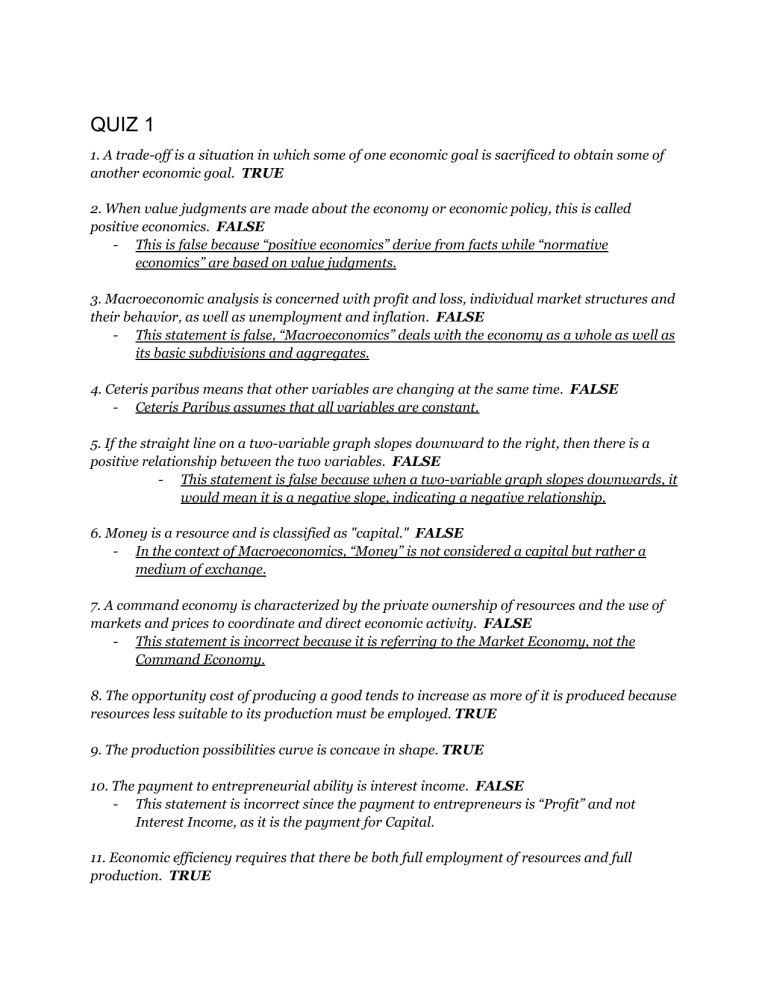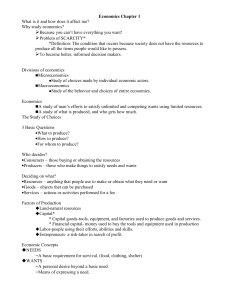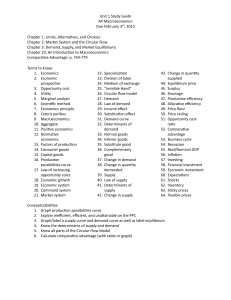
QUIZ 1 1. A trade-off is a situation in which some of one economic goal is sacrificed to obtain some of another economic goal. TRUE 2. When value judgments are made about the economy or economic policy, this is called positive economics. FALSE - This is false because “positive economics” derive from facts while “normative economics” are based on value judgments. 3. Macroeconomic analysis is concerned with profit and loss, individual market structures and their behavior, as well as unemployment and inflation. FALSE - This statement is false, “Macroeconomics” deals with the economy as a whole as well as its basic subdivisions and aggregates. 4. Ceteris paribus means that other variables are changing at the same time. FALSE - Ceteris Paribus assumes that all variables are constant. 5. If the straight line on a two-variable graph slopes downward to the right, then there is a positive relationship between the two variables. FALSE - This statement is false because when a two-variable graph slopes downwards, it would mean it is a negative slope, indicating a negative relationship. 6. Money is a resource and is classified as "capital." FALSE - In the context of Macroeconomics, “Money” is not considered a capital but rather a medium of exchange. 7. A command economy is characterized by the private ownership of resources and the use of markets and prices to coordinate and direct economic activity. FALSE - This statement is incorrect because it is referring to the Market Economy, not the Command Economy. 8. The opportunity cost of producing a good tends to increase as more of it is produced because resources less suitable to its production must be employed. TRUE 9. The production possibilities curve is concave in shape. TRUE 10. The payment to entrepreneurial ability is interest income. FALSE - This statement is incorrect since the payment to entrepreneurs is “Profit” and not Interest Income, as it is the payment for Capital. 11. Economic efficiency requires that there be both full employment of resources and full production. TRUE 12. Adam Smith is the Father of Economics. TRUE 13. Technological advancements and increased availability of resources could cause the production possibilities curve to shift inward. FALSE - This is incorrect because technological advancements would reduce the production cost of producing a good. If an increased availability of resources accompanies it, the production possibilities curve will expand rather than shifting inwards. 14. Essential needs are defined as the most elementary consumption requirements that would allow man's survival. FALSE - The statement is referring to “Basic Needs.” 15. A variable that changes as a consequence of a change in another variable is considered a dependent variable. TRUE **16. A dependent variable is plotted along the X-axis. FALSE 17. If X is an independent variable and Y is a dependent variable, then a change in Y results in a change in X. FALSE - The statement is incorrect because, given the context, An independent variable should not change due to a change in the dependent variable but rather the opposite. 18. Economics is a social science, just like Physics, Chemistry and Zoology. FALSE - This statement is incorrect because “Economics” may be defined as a social science but not a “social science” like Physics and Zoology since Economics is only recognized as a branch of Sociology. 19. Underemployment may result to a combination of goods within the feasible set. TRUE - The statement above is true because even though a combination can be found within the feasible set, it does not mean we are practicing the four assumptions of the production possibility curve. The area inside the curve indicated that there are assumptions that are not being practiced. 20. In the circular flow model, households function on the buying side of the resource and product markets. FALSE - The statement is incorrect because the households are the ones “selling” in the resource and product market. 21. The more capital goods an economy produces today, the greater will be the output of all goods it can produce in the future, other things being equal. TRUE 22. The liberal or expansionary policy is implemented during periods of prosperity or boom. FALSE - This is false because if an economy is experiencing prosperity or boom, the economy needs to balance its growth and will most likely need policies that would encourage people NOT to spend, which means that the economy would need more inflows than outflows. 23. In the ratio for the calculation of the slope of a straight line, the vertical change is the numerator and the horizontal change is the denominator. TRUE 24. Economics came from the Latin word "oekonomia." FALSE - The statement is false because economics was first called “Oikos” but then turned into “Oekonomia” by author Villegas. 25. Economic resources come in the form of land, labor, capital, and entrepreneurship. TRUE DEFINE ECONOMICS: Economics is a social science that studies and seeks to allocate scarce human and non-human resources among their alternative uses to satisfy man’s unlimited wants and needs. Expound on PPC: PPC, or production possibilities curve, is a schedule that shows the various combinations of 2 goods that the society is capable of producing under four assumptions. The first assumption is that in producing those two goods, we are practicing Full Employment and Productive Efficiency. Full employment means that all resources are being fully utilized, while Productive Efficiency means that in producing these two goods, we are producing in the least costly manner. The second assumption is that we have fixed resources, meaning that we can neither increase nor decrease the amount of resources for a period of time. The third assumption is that we have fixed technology. “Technology” in this context refers to the manner we do things; fixed technology means that the manner we do things is fixed for a period of time. The last assumption is that we are capable of only producing two goods. The production possibilities curve possesses two principles of macroeconomics, which are the concept of “trade-off” and “increasing opportunity costs.” In PPC, it is shown that as we desire to produce more of one good, we do it at the expense of the other good. The production possibilities curve can also be called the production possibilities “frontier.” Frontier means boundary. The curve itself serves as a boundary that presents the capability of producing these two goods. PPC is concave. The area inside the curve is called the “feasible set.” Combinations found inside the curve are the combinations that the firm is capable of producing. It is important to note that if a combination lies inside the curve. the firm is most likely not practicing the four assumptions that are mentioned above because it is most likely that when a combination is inside the curve, the firm has not fully utilized the available resources.






